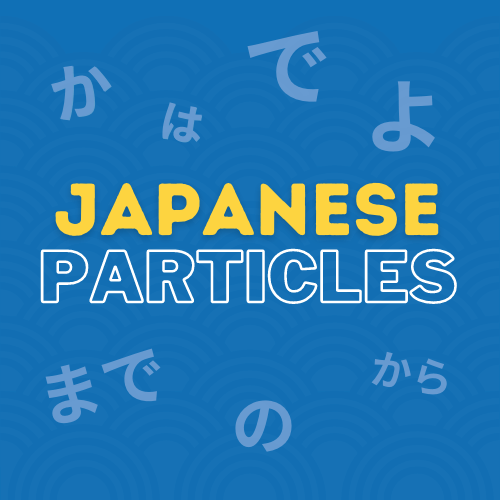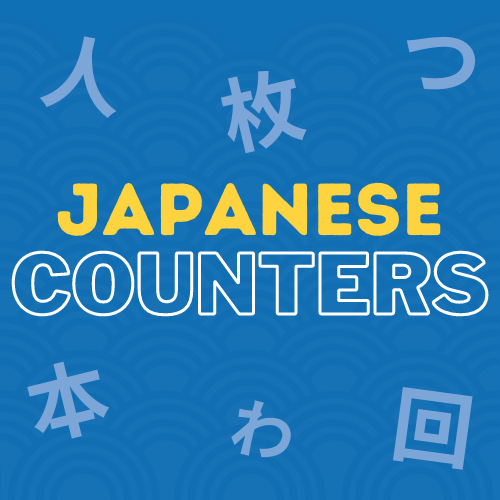Japanese Grammar Bank // Japanese Particles
Welcome to this lesson on basic Japanese particles!
Particles are an essential part of the Japanese language. The subject, the object and places are all indicated by specific particles.
There are 188 Japanese particles in total and many have more than one usage, but we will start with the most important ones.
Today we are going to introduce you to some basic and more advanced Japanese particles and their usage in a sentence.
To help you remember, we will provide you with examples of some basic formations used to create a sentence.

Basic Particles
Japanese Particles | Topic Marker は
Japanese Particles | Question Particle か
Japanese Particles | Possessive Particle の
Japanese Particles | Addition Marker も
Japanese Particles | Direct Object Marker を
Japanese Particles | Connecting Particle と
Japanese Particles | Connecting Particle や
Advanced Particles
Japanese Particles | Subject Particle が
Japanese Particles | Target Particle に
Japanese Particles | Starting Point Particle から
Japanese Particles | End Point Marker まで
Japanese Particles | Direction Marker へ
Japanese Particles | Location Particle で
Japanese Particles | Confirmation Particle ね
Japanese Particles | Emphasis Marker よ
Basic Japanese Particles | The Topic Marker は
The particle は is used as a topic marker and is attached after a noun.
While learning Hiragana, we have learned that, ‘は’ is normally pronounced ‘ha’. However, when used as a particle, は should be pronounced as ‘wa’.
は is the MOST used particle in Japanese language.
For example:
| Example | Hiragana | Romanisation | English |
|---|---|---|---|
| 私は学生です。 | わたしはがくせいです。 | Watashi wa gakusei desu. | I am a student. |
As you study further you will notice that in a conversation if the topic has not changed, ‘は’ is omitted as both the speaker and the listener understands the context and the topic of the conversation.
NOTE || Learn more about the Topic Marker は here.
Basic Japanese Particles | The Question Particle か
When studying and practicing a new language, there will obviously be many instances where you’ll want to ask questions.
At that time, all you have to do is to use the particle か (ka) at the end of the sentence.
か (ka) is used just like a question mark at the end of a sentence to make a question.
Any sentence can be turned in to a question if か is added at the end.
It is as simple as that!
For example:
| Example | Hiragana | Romanisation | English |
|---|---|---|---|
| 田中さんは学生ですか。 | たなかさんはがくせいですか。 | Tanakasan wa gakusei desu ka. | Is Mr. Tanaka a student? |
The question mark as we know it, “?”, is never used in the Japanese Language: わかりましたか。(Did you understand?)
NOTE || Learn more about Japanese Questions here.
Basic Japanese Particles | The Possessive Particle の
の (no) is the particle used to indicate ownership or association.
It is also used to indicate category of a thing or to state relationship between two things.
For example:
| Example | Hiragana | Romanisation | English |
|---|---|---|---|
| 私は日本語の学生です。 | わたしはにほんごのがくせいです。 | Watashi wa nihongo no gakusei desu. | I am a student of Japanese Language. / I am a Japanese Language student. |
Even though the first translated sentence sounds a bit weird, that would be literal translation of the sentence in Japanese.
If we compare to the English language, の particle has the same meaning as ‘of’ or as ‘s.
NOTE || Learn more about the Possessive Particle の here.
Basic Japanese Particles | The Addition Marker も
も (mo) is used has the same meaning as ‘also’, ‘as well as’ or ‘too’ in English.
It indicates that something which was previously stated is also true for the current topic discussed.
For example:
| 私は日本語の学生です。田中さんも日本語の学生です。 |
| わたしはにほんごのがくせいです。たなかさんもにほんごのがくせいです。 |
| Watashi wa nihongo no gakusei desu. Tanakasan mo nihongo no gakusei desu. |
| I am a Japanese language student. Mr. Tanaka is also a Japanese language student. |
Basic Japanese Particles | The Direct Object Marker を
If you’re performing an action on some object, the particle を (wo) is used.
It is also known as the object marker of the sentence and is used after a noun in the sentence.
For example:
| Example | Hiragana | Romanisation | English |
|---|---|---|---|
| 私は寿司を食べます。 | わたしはすしをたべます。 | Watashi wa sushi wo tabemasu. | I eat sushi. |
NOTE || Learn more about the Object Marker を here.
Basic Japanese Particles | The Connecting Particle と
The と (to) particle is used as ‘and’ in English.
It is used to speak about more than one object.
For example:
| Example | Hiragana | Romanisation | English |
|---|---|---|---|
| 教室の中に男の子と女の子がいます。 | きょうしつのなかにおとこのことおんなのこがいます。 | Kyoushutsu no nakani otokonoko to onnanoko ga imasu. | There is a boy and a girl in the classroom. |
Remember, when we use particle と, we have to mention all the items present. The particle が is attached to the last thing mentioned.
Basic Japanese Particles | The Connecting Particle や
The や (ya) particle is also used to connect different nouns when more than one noun needs to be mentioned.
The difference between と and や is we can use や when we don’t want to mention all the objects present.
For example:
| Example | Hiragana | Romanisation | English |
|---|---|---|---|
| 本や鉛筆があります。 | ほんやえんぴつがあります。 | Hon ya enpitsu ga arimasu. | There is a book and pencil. |
We can also add など (nado) which means etc / other such things.
| Example | Hiragana | Romanisation | English |
|---|---|---|---|
| 本や鉛筆などがあります。 | ほんやえんぴつなどがあります。 | Hon ya enpitsu nado ga arimasu. | There is a book, a pencil and other such things. |
Keep in mind that など can NEVER be used with と.
You’ve just learned 7 basic Japanese particles, congratulations!
Let’s learn some more tricky ones now. Stay focused, because some particles have more than one usage!
Advanced Japanese Particles | The Subject Particle が
The が (ga) particle is used to talk about the existence of an object or a person.
It is attached to the noun indicating an object or person whose existence is to be highlighted.
The particle が is also used to indicate new information or to give special emphasis on the object.
- Note that for indicating the existence of a non-living thing, we use the verb ‘ある’ i.e., ‘aru’.
- Whereas, for indicating the existence of a living thing, we use the verb ‘いる’ i.e., ‘iru’.
For example:
| Example 1 | Example 2 |
|---|---|
| 机があります。 | 学生がいます。 |
| つくえがあります。 | がくせいがいます。 |
| Tsukue ga arimasu. | Gakusei ga imasu. |
| There is a table. | There is a student. |
Question words are unknown entities so they cannot be topics.
Hence, while starting a sentence with question words, instead of は, particle が is used. The answers to questions with particle が, are also given with particle が.
For example:
| Example | Hiragana | Romanisation | English |
|---|---|---|---|
| 誰が来ますか。 | だれがきますか。 | Dare ga kimasuka. | Who will come? |
が is also used as ‘but’ while joining two sentences, i.e., as a conjunction particle.
NOTE || Learn more about the Subject Particle が here.
Advanced Japanese Particles | The Target Particle に
に (ni) is known as the target, or location marker in Japanese.
It indicates the place where someone or something exists.
For example:
| Example | Hiragana | Romanisation | English |
|---|---|---|---|
| 教室に机があります。 | きょうしつにつくえがあります。 | Kyoushitsu ni tsukue ga arimasu. | There is a table in that classroom. |
Another use of particle に is as a specific time marker. When we have to indicate a specific time at which a certain action is performed, we use this particle.
We know how famous Japan is for punctuality. You might want to arrive at your given destination 15 minutes earlier!
For example:
| Example | Hiragana | Romanisation | English |
|---|---|---|---|
| 私は6時に行きます。 | わたしは6じにいきます。 | Watashi wa 6 ji ni ikimasu. | I’ll go at 6. |
Note that particle に is only used with a specific time and never with relative times like tomorrow or next week.
Advanced Japanese Particles | The Starting Point Particle から
You will probably travel a lot when exploring the beauty of Japan. You might need this particle to ask about location as well as time.
This particle is pronounced ‘kara’ and is similar to ‘from’ in English.
Just like English, it can be used both for location as well as time.
For example:
| Example | Hiragana | Romanisation | English |
|---|---|---|---|
| 会社から家に帰ります。 | かいしゃからいえにかえります。 | Kaisha kara iie ni kaerimasu. | I return to home from work. |
Advanced Japanese Particles | The End Point Marker まで
The marker まで (made) is used similarly to ‘to’ or ‘until’ in English. Just like in English, it can be used both for location as well as time.
When used together, から and まで indicate a timespan of an event or distance between two locations.
For example:
| Example | Hiragana | Romanisation | English |
|---|---|---|---|
| 会議は2時から3時まであります。 | かいぎは2じから3じまであります。 | Kaigi wa 2 ji kara 3 ji made arimasu. | The meeting will be from 2 to 3. |
Advanced Japanese Particles | The Direction Marker へ
We’ve seen in our previous Hiragana lesson that へ is pronounced ‘he’. However, when used as a particle, it is pronounced ‘ae’.
This particle indicates the direction of a movement. It is attached after the noun indicating a place.
For example:
| Example | Hiragana | Romanisation | English |
|---|---|---|---|
| 毎日学校へ行きます。 | まいにちがっこうへいきます。 | Mainichi gakkou ae ikimasu. | Every day, I go to school. |
The marker へ is only used with motion verbs, which are:
- 行く : いく (To go)
- 来る : くる (To come)
- 帰る : かえる (To return)
Advanced Japanese Particles | The Location Particle で
The particle で (de) is another location related particle. So many location particles, right?
But, rather than just a location, this particle indicates the place of action.
For example:
| Example | Hiragana | Romanisation | English |
|---|---|---|---|
| 私は会社で働きます。 | わたしはかいしゃではたらきます。 | Watashi wa kaishya de hatarakimasu. | I work at a company. |
Advanced Japanese Particles | The Confirmation Particle ね
The particle ね (ne) is used to indicate the confirmation on the information that is being spoken.
Sometimes, this particle is used just to add a little flavour to speech and the listener is not expected to give any answer.
For example:
| Example | Hiragana | Romanisation | English |
|---|---|---|---|
| 田中さんは学生ですね。 | たなかさんはがくせいですね。 | Tanakasan wa gakusei desune. | Mr. Tanaka is a student, right? |
TOP TIP | A common example of this in practice is when Speaker A makes a statement and Speaker B agrees. Speaker B would reply with そうですね (sou desune). This essentially means “Yes, I agree”.
Advanced Japanese Particles | The Emphasis Marker よ
Just like ね, よ (yo) is used at the end of the sentence.
It can be compared to the English expression ‘you know?‘.
This particle can add emphasis to a sentence or suggest that the speaker is sharing new information.
For example:
| Example | Hiragana | Romanisation | English |
|---|---|---|---|
| 明日は日曜日ですよ。 | あしたはにちようびですよ。 | Ashita wa nichiyoubi desu yo. | Tomorrow is a Sunday, you know? |
Learning to use ね and よ properly in a conversation can make you sound a little more natural like a native Japanese speaker.

Are you a Flexi Classes student already?
Learn more about Basic Particles in Japanese in the following Flexi lessons:
My Father Is A Teacher (Intro)
What Is Your Job? (A1, Chapter 1)
This Is The Key (A1, Chapter 1)
Not a Flexi Student yet?
If you got this far, congratulations! This was no easy lesson, and there’s a lot to learn here.
Particles and markers are an essential aspect of the Japanese language, so you should definitely start to learn them early.
Start with the basic Japanese particles and work your way up to the more advanced ones.
Here’s a reminder of some of the other lessons we have in our Japanese Grammar Bank:
FREQUENTLY ASKED QUESTIONS
What is a particle in Japanese?
Particles are an essential part of the Japanese language.
The subject, the object and places are all indicated by specific particles.
There are 188 Japanese particles in total and many have more than one usage, so make sure to check our guide to the most important Japanese particles to learn.
What are some basic Japanese particles I should know?
Some of the basic Japanese particles you should know about early in your studies are:
The Topic Marker は
The Question Particle か
The Possessive Particle の
The Addition Marker も
The Direct Object Marker を
The Connecting Particles と and や
You can learn all about them in our guide, with examples!
What are some advanced Japanese particles?
Some advanced Japanese particles to know are:
The Subject Particle が
The Target Particle に
The Starting Point Particle から
The End Point Marker まで
The Direction Marker へ
The Location Particle で
The Confirmation Particle ね
The Emphasis Marker よ
They are called “advanced” because some of them are a bit more difficult to use, or have multiple usages to know about.
What is the Japanese question marker?
か (ka) is used just like a question mark at the end of a sentence to make a question.
Any sentence can be turned into a question if か is added at the end.
Did you know?
The question mark as we know it, “?”, is never used in the Japanese Language
What is the Japanese topic marker?
The particle は is used as a topic marker and is attached after a noun.
While learning Hiragana, we have learned that, ‘は’ is normally pronounced ‘ha’.
However, when used as a particle, は should be pronounced as ‘wa’.
は is the MOST used particle in Japanese language.
What is the Japanese possessive particle?
の (no) is the particle used to indicate ownership or association.
It is also used to indicate category of a thing or to state relationship between two things.









